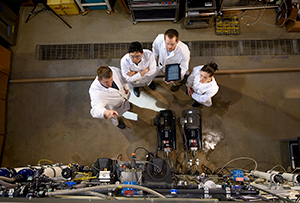
Contact Us
Institutional Communications
Bureau of Mines Building, Room 137
Laramie, WY 82071
Phone: (307) 766-2929
Email: cbaldwin@uwyo.edu
UWs Brant Leads Research to Boost Oilfield Wastewater Treatment
Published November 05, 2019

UW Associate Professor Jonathon Brant (left) works with students in his water resources
laboratory, where he researches physicochemical separation processes for water and
industrial wastewater treatment. (UW Photo)
University of Wyoming civil and architectural engineering Associate Professor Jonathan Brant will lead research into improving oil and gas wastewater discharge in Wyoming’s Green River Basin with a new grant of about $1 million from the U.S. Department of Energy.
Brant’s project was one of four selected recently by the Office of Fossil Energy to receive federal funding for cost-shared research and development to commercialize treatment technologies to reduce wastewater that is being injected into disposal wells -- and increase water supplies for reuse.
Over the next two years, Brant’s primary objective will be to manufacture two membrane prototypes, superhydrophobic and superhydrophilic, for field evaluation in the greater Green River Basin. The superhydrophobic prototype membrane is designed for selectively removing oil and BTEX compounds from produced waters. BTEX refers to the chemicals benzene, toluene, ethylbenzene and xylene, which occur naturally in crude oil and can be found in the vicinity of natural gas and petroleum deposits.
The second, superhydrophilic membrane prototype’s purpose is to separate water from other substances following the oil and BTEX separation process. When operated in a series, the research could allow for the recovery of oil and BTEX, which can generate revenue for producers and also the production of clean, reusable water.
Brant and his team, including co-principal investigator and UW Department of Mathematics and Statistics Professor Stefan Heinz, will use novel synthesis techniques called electrospinning and electrospraying to make the microporous membranes.
Electrospinning is a method to produce ultrafine nanofibers by charging and ejecting a polymer melt or solution through a spinneret under a high-voltage electric field in order to form a filament. Electrospray is the product of a special liquid atomization process that relies on the electrostatic force to break a liquid of finite conductivity into a plume of highly charged fine droplets. This highly precise process is more cost-effective than traditional polymerization techniques and overcomes many challenges found in conventional processes.
Eventually, Brant intends to create a platform for the commercial production of electrospun and electrospray membranes for water treatment and resource recovery. Additionally, he foresees the potential of a startup company to support the outcomes of the research.
“This work will result in the development of pre-commercial membrane prototypes ready for field testing,” Brant says. “Coupled with the pilot-scale electrospinning and electrospraying membrane production equipment, it will position UW to form both a spin-off company focused on the production of novel membranes for deployment in the oil and gas industry, and to take the lead in this type of membrane research in the U.S.”
Grant winners also each received a $25,000 award in recognition of their innovative technologies and solutions. Their proposals were selected based on criteria that included minimization of waste streams, technology design and per-barrel cost.
Brant is a licensed professional environmental engineer in Wyoming and has over 15 years of experience as a consulting water treatment engineer and researcher scientist. His area of expertise is physicochemical separation processes, with an emphasis on membrane processes. His current research projects and interests include process development for recovering rare earth elements and precious metals from produced waters and other brines; development of nanocomposite membranes for thermally driven separation processes for produced water management; synthesis of engineered nanomaterials for water treatment applications; and characterization of the environmental implications of nanotechnology.
Contact Us
Institutional Communications
Bureau of Mines Building, Room 137
Laramie, WY 82071
Phone: (307) 766-2929
Email: cbaldwin@uwyo.edu
